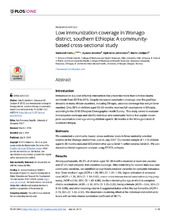| dc.description.abstract | Introduction Immunization is a cost-effective intervention that prevented more than 5 million deaths worldwide from 2010 to 2015. Despite increased vaccination coverage over the past four decades in many African countries, including Ethiopia, universal coverage has not yet been reached. Only 39% of children aged 12–23 months received full vaccinations in Ethiopia, according to the 2016 Ethiopian Demographic Health Survey. This study aimed to evaluate immunization coverage and identify individual and community factors that explain incomplete vaccination coverage among children aged 6–36 months in the Wonago district of southern Ethiopia. Methods We conducted a community-based, cross-sectional study in three randomly selected kebeles in the Wonago district from June to July 2017. Our nested sample of 1,116 children aged 6–36 months included 923 child-mother pairs (level 1) within kebeles (level 2). We conducted multilevel regression analysis using STATA software. Results Among participants, 85.0% of children aged 12–36 months received at least one vaccine, and 52.4% had complete immunization coverage. After controlling for several individual and community variables, we identified six significant predictor variables for complete immunization: Older mothers’ age (AOR = 1.05, 95% CI: 1.00–1.09), higher utilization of antenatal care (AOR = 1.36, 95% CI: 1.14–1.62), one or more tetanus-toxoid vaccination during pregnancy (AOR = 2.64, 95% CI: 1.43–4.86), mothers knowing the age at which to complete child’s vaccinations (AOR = 2.00, 95% CI: 1.25–3.20), being a female (AOR = 0.64, 95% CI: 0.43–0.95), and child receiving vitamin A supplementation within the last 6 months (AOR = 2.79, 95% CI: 1.59–4.90). We observed a clustering effect at the individual and community levels with an intra-cluster correlation coefficient of 48.1%. Conclusions We found low immunization coverage among children in the Wonago district of southern Ethiopia, with significant differences across communities. Promoting maternal health care and community service could enhance immunization coverage. | en_US |

